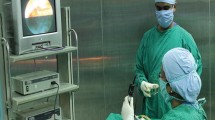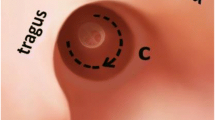Abstract
The objective of this study is to determine the nature, duration and severity of chorda tympani symptoms in post-stapedotomy patients when the nerve has been known to have either sustained surgical manipulation or division. The study design was retrospective and blind, based at a tertiary Otology Referral Center (Gloucestershire Royal Hospital). All successive patients undergoing stapedotomy operated upon by the senior author (JMR) between November 1991 and October 1998 were included. The main outcome measures were postoperative graded dysgeusia (questionnaire) and post operative electrogustometry score, comparing the chorda tympani cut group and the chorda tympani preserved group. Sixty stapedotomies were performed in the study period. After a minimum interval of 8 months, questionnaire data were obtained in 55/60 (92%), and electrogustometry studies were carried out in 48/60 (80%). Symptoms of dysgeusia were experienced in the chorda tympani nerve cut (CC) group in 95% and in the chorda preserved (CP) group in 52%. For those with symptoms, duration was 6.7 months (±4.9 SD) and 3.4 months (±3.7 SD) for the CC and CP groups, respectively. From the electrogustometry data, after 8 months, the risk of total loss of response is significantly higher in CC patients (94%) than in CP patients (25%) (P=0.0001). Also at 8 months, 54% of CP patients had normal ipsilateral electrogustometry responses compared with 6% in the CC group. In conclusion, cutting the chorda tympani results in significantly greater symptoms than when subjected to manipulation only, and these symptoms are likely to be more long lasting. Therefore, it is our recommendation that where possible the chorda be preserved. The risk of severe chorda symptoms when the chorda is cut is small (<5%). Preoperative consent to include dysgeusia is advised.



Similar content being viewed by others
References
Bull TR (1965) Taste and the chorda tympani. J Laryngol Otol 79:479–493
Ceilis-Bloubach A (1970) Chordal disguise. Arch Otolaryng 92:76–79
Tomita H, Ikeda M, Okuda Y (1986) Basis and practice of clinical taste examinations. Auris Nasus Larynx 13 [Suppl 1]:1–15
Causse JB, Causse JR (1984) Technique for otosclerosis. Am J Otol 5:392–396
Causse JB, Causse JR, Parahy C (1985) Stapedotomy technique and results. Am J Otol 6:68–71
Grant R, Ferguson MM, Strang R, Turner S, Bone I (1987) Evoked taste thresholds in a normal population and the application of electrogustometry to trigeminal nerve disease. J Neurol Neurosurg Psychiatry 50:12–21
Stillman JA, Morton RP, Hay KD, Ahmand Z, Goldsmith D (2003) Electrogustometry: strengths, weaknesses, and clinical evidence of stimulus boundaries. Clin. Otolaryngol 28:406–410
Yanagisawa K, Barstoshuk LM, Catalanotto FA, Karrer TA, Kveton JF (1998) Anaesthesia of the chorda tympani nerve and taste phantoms. Physiol Behav 63:329–335
Robbins N (1967) “Electric taste” after section of the chorda tympani. Nature 214:1113–1114
Sulzer M (1926) Recherches sur l’origine des sentiments agréables et désagréables. Troisième partie: des plaisirs des sens. Histoire de l’académie des Sciences et Bells Lettres de Berlin (Année 1752) 1754. In: Skramlik E von (ed) Handbuch der Physiologie der Niederen Sinne. J Bd S 378. Thieme, Leipzig
Skouby AP, Zilstorff-Pedersen K (1955) The influence of acetylcholine, menthol and strychnine on taste receptors in man. Acta Physiol Scand 34:250–256
Krarup B (1958) On technique of gustometry assessment. Acta Otolaryngol 140 [Suppl]:195–200
Murphy C, Quinonez C, Nordin S (1995) Reliability and validity of electrogustometry and its application to young and elderly persons. Chem Senses 20:499–503
Grant R, Miller S, Simpson D, Lamey PJ, Bones I (1989) The effect of chorda tympani section on ipsilateral and contralateral salivary secretion and taste in man. J Neurol Neurosurg Psychiatry 52:1008–1062
Halpern BP, Nelson LM (1967) Bulbar gustatory responses to anterior and to posterior tongue stimulation in the rat. Am J Physiol 209:105–110
Tomita H, Ikeda M (2002) Clincal use of electrogustometry: strengths and limitations. Acta Otolaryngol [Suppl] 546:27–38
Bartoshuk LM (1978) The psychophysics of taste. Am J Clin Nutr 31:1068–1077
Yeo SB, Loy AHC (1997) Chorda tympani trauma—how much does it affect taste? Singapore Med J 38:329–331
Saito T, Shibamori Y, Manabe Y, Yamagishi T, Yamamoto T, Ohtsubo T, Saito H (2000) Morphological and functional study of regenerated chorda tympani nerves in humans. Ann Otol Rhinol Laryngol 109:703–709
Ohishi Y, Komiyama S, Shiba Y (2000) Predominant role of the chorda tympani nerve in the maintenance of the taste pores: the influence of gustatory denervation in ear surgery. J Laryngol Otol 114:576–580
Coats AC (1974) Normal limit of the electrogustometry test. Ann Otol Rhinol Laryngol 83:491–497
Jeppson PH (1969) Studies on the structure and innervation of taste buds. Acta Otolaryngol [Suppl] (Stockh) 259:7–15
Saito T, Manabe Y, Shibamori Y, Yamagishi T, Igawa H, Tokoriki, M, Fukuoka Y, Noda I, Ohtsubo T, Saito H (2001) Long-term follow-up results of electrogustometry and subjective taste disorder after middle ear surgery. Laryngoscope 111:2064–2070
Author information
Authors and Affiliations
Corresponding author
Rights and permissions
About this article
Cite this article
Mahendran, S., Hogg, R. & Robinson, J.M. To divide or manipulate the chorda tympani in stapedotomy. Eur Arch Otorhinolaryngol 262, 482–487 (2005). https://doi.org/10.1007/s00405-004-0854-5
Received:
Accepted:
Published:
Issue Date:
DOI: https://doi.org/10.1007/s00405-004-0854-5




